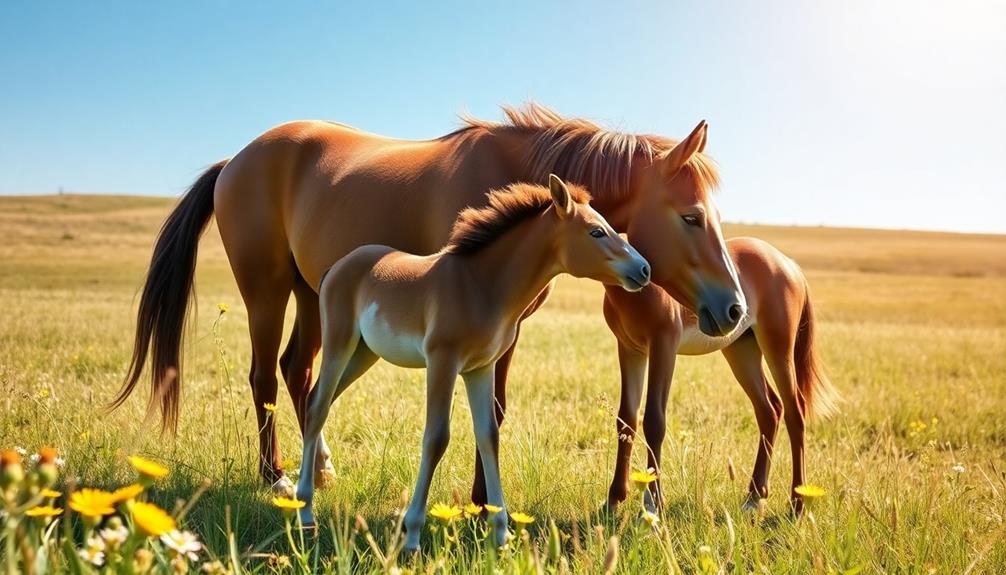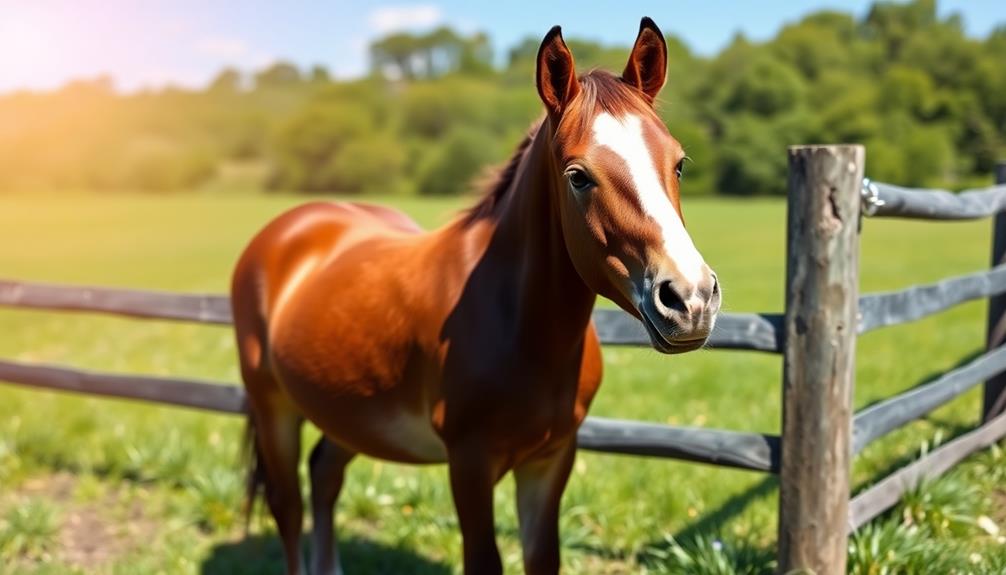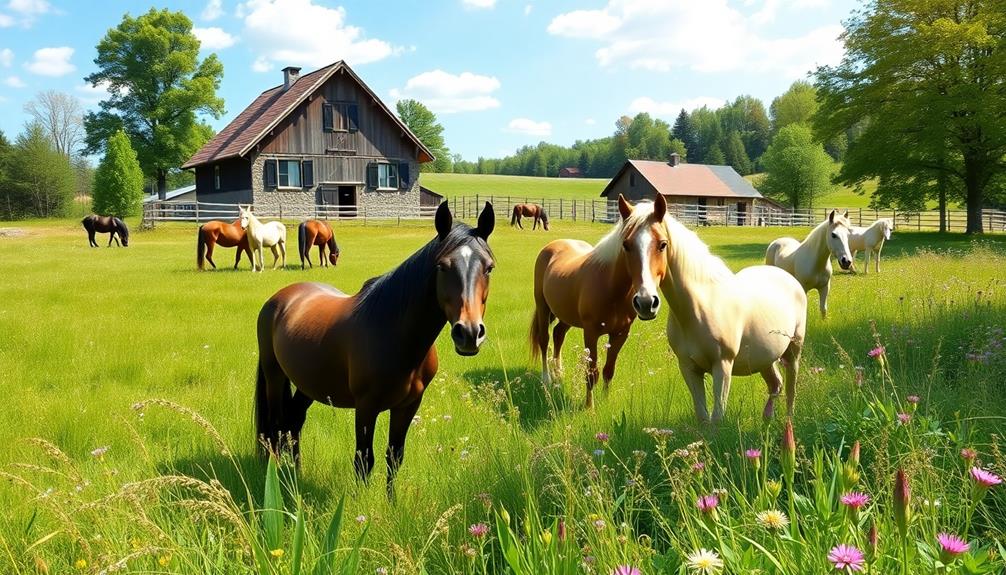Mini horses are generally pregnant for about 11 months, with gestation lasting between 326 and 354 days. While the average is around 330 days, some mares can foal as early as 290 days or as late as 380 days. Several factors can influence these lengths, including the mare's age, health, and environmental conditions. It's important to monitor signs of pregnancy, like weight gain and udder development, as the due date approaches. Keeping an eye on your mare's condition will help guarantee a smooth foaling process, and there's much more to discover about caring for her during this period.
Key Takeaways
- Miniature horses have an average gestation period of about 330 days, typically ranging from 326 to 354 days.
- Factors such as the mare's age, health, and environmental conditions can influence gestation length significantly.
- Signs of pregnancy include behavioral changes, weight gain, abdominal enlargement, and mammary gland development.
- Foaling typically occurs within 24 hours of noticeable signs, like udder swelling and increased restlessness in the mare.
- Post-foaling care includes monitoring the mare and foal's health, treating the umbilical cord, and inspecting the placenta promptly.
Overview of Mini Horse Gestation
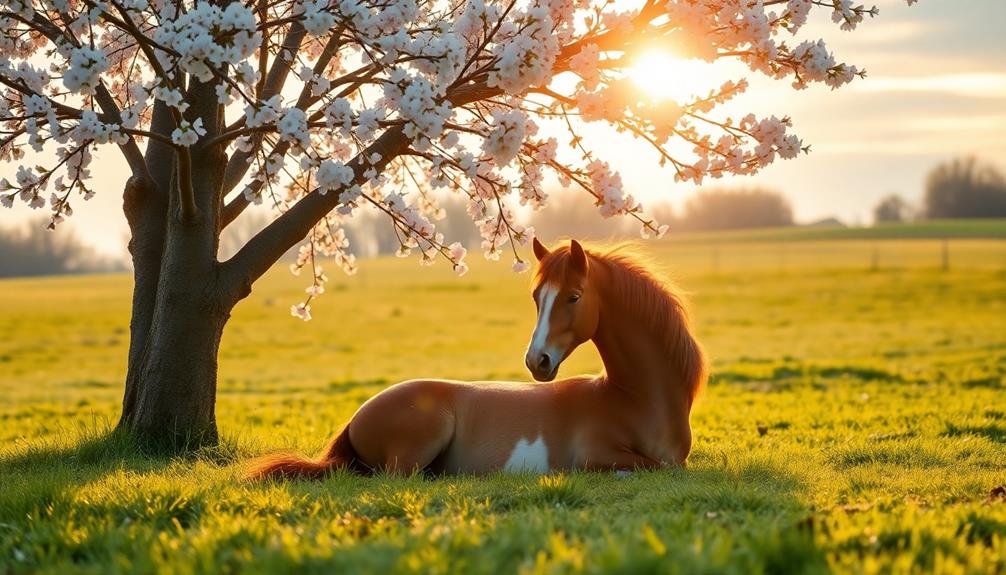
When it comes to miniature horses, understanding their gestation is vital for any owner or breeder. Miniature mares typically have an average gestation length of about 11 months, which usually falls between 326 and 354 days.
However, it's significant to acknowledge that gestation lengths can vary considerably. Some mares might foal as early as 290 days, while others may carry their foals for up to 380 days.
Several factors can influence this gestation duration, including the mare's age, overall health, environmental conditions, and the specific breeding season. Most miniature mares carry just a single foal, as twins are quite rare.
Keep in mind that each mare has her own pregnancy history, which can affect the consistency of her gestation lengths.
As the expected foaling date approaches—generally around 330 days from the last breeding date—monitoring for signs of pregnancy and changes in the mare's condition becomes essential.
Average Pregnancy Duration

Understanding the average pregnancy duration for miniature horses is vital for any owner or breeder. Typically, a miniature horse is pregnant for about 330 days, which equates to roughly 11 months.
However, you should be aware that gestation lengths can vary widely. Some mares may give birth as early as 290 days, while others can carry their foals for up to 350 days.
Most breeders recognize a commonly accepted average gestation period of around 326 days, but individual experiences can differ. Factors such as the mare's age and overall health can greatly influence the length of gestation.
Additionally, environmental conditions may also play a role in how long a miniature horse stays pregnant.
You might notice that individual mare histories often affect gestation length consistency; this means you'll see notable variations even among mares with similar breeding conditions.
It's important to keep these factors in mind when planning for your miniature horse's pregnancy. Being informed allows you to better prepare for the arrival of the foal, ensuring both the mare and her baby are healthy and ready for the next steps in their journey together.
Factors Affecting Gestation Length

Gestation length for miniature horses can be influenced by a variety of factors. Typically, the average gestation lasts between 300 to 340 days, but several elements can affect this timing. Understanding these factors can help you better prepare for foaling.
Here are three key factors that can affect gestation length in mini horses:
- Mare's Age and Breeding History: Older mares or those with varied breeding experiences might experience different gestation durations.
- Stallion Influence: The stallion's genetics and health can impact how long the pregnancy lasts, adding variability to the gestation length.
- Environmental Conditions: Seasonal factors, such as the time of year and weather conditions, can also play a role. Stress or changes in nutrition during this period will further influence the health of the mare and the length of her gestation.
Signs of Pregnancy in Mares
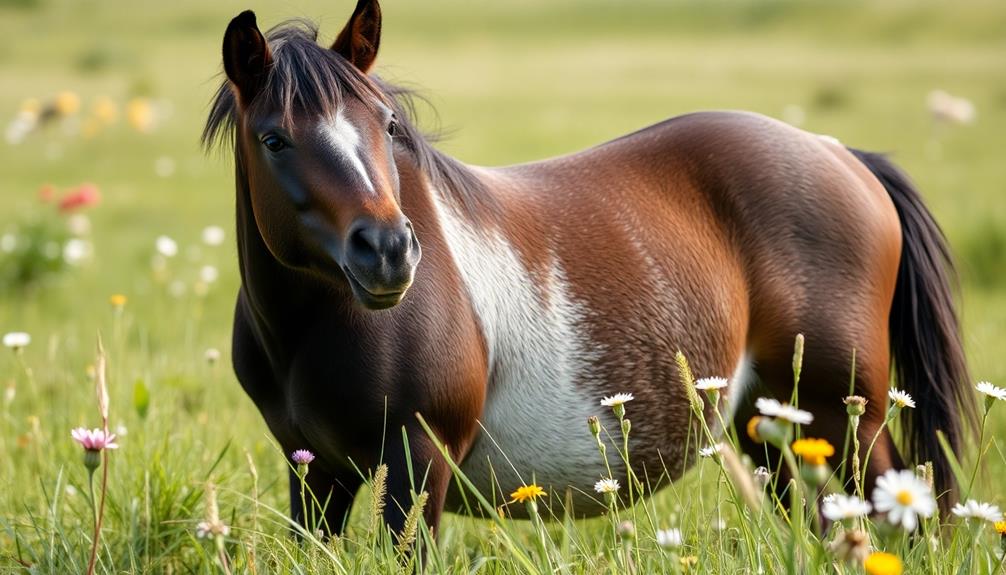
When a mare is pregnant, you'll notice some key behavioral changes, like increased affection or moments of solitude.
Physically, she may start gaining weight and her abdomen will enlarge as the pregnancy progresses.
Keeping an eye on these signs is essential for anticipating the arrival of her foal.
Behavioral Changes During Pregnancy
Pregnant mares often show noticeable behavioral changes that can signal their condition. These behavioral changes can vary, but you might observe the following:
- Increased Affection: Many Miniature Horses become more affectionate, seeking your attention and companionship, wanting to be close to you.
- Seeking Isolation: Conversely, some mares may prefer solitude, distancing themselves from other horses and people as they focus on their pregnancy.
- Changes in Appetite: You might notice shifts in their eating habits, with some mares developing cravings for specific foods as their pregnancy progresses.
As the due date approaches, you may also see signs of nesting behavior or increased restlessness, indicating that labor is nearing.
These behavioral changes can reflect the mare's emotional and physical adjustments during pregnancy. By paying attention to these signs, you can better understand and care for your pregnant mare.
Remember that while these changes are common, individual mares may demonstrate them differently. Keeping a close eye on your Miniature Horses during this period will help guarantee a healthy pregnancy and a smooth shift into motherhood.
Physical Signs of Pregnancy
Recognizing the physical signs of pregnancy in Miniature Horses is essential for any owner. As your mare becomes pregnant, you may notice noticeable weight gain and abdominal enlargement, especially as time goes on. This weight gain is one of the primary physical signs that indicate horse pregnancy.
Around 4 to 6 weeks before foaling, you'll likely observe the development of the mammary glands, often called "bagging up." This is a clear indicator that the foaling is approaching. You might also see prominent veins along the udder as the pregnancy progresses.
Changes in behavior are common too; your mare may seek isolation or show increased affection. An uptick in appetite can also be a sign of her growing baby.
As foaling nears, you may notice a "jelly-like" consistency in the butt area, indicating that she's getting ready.
Pay close attention to udder changes, including filling and the appearance of wax on the teats, which typically occurs within 24 hours of expected foaling.
Stages of Pregnancy Development
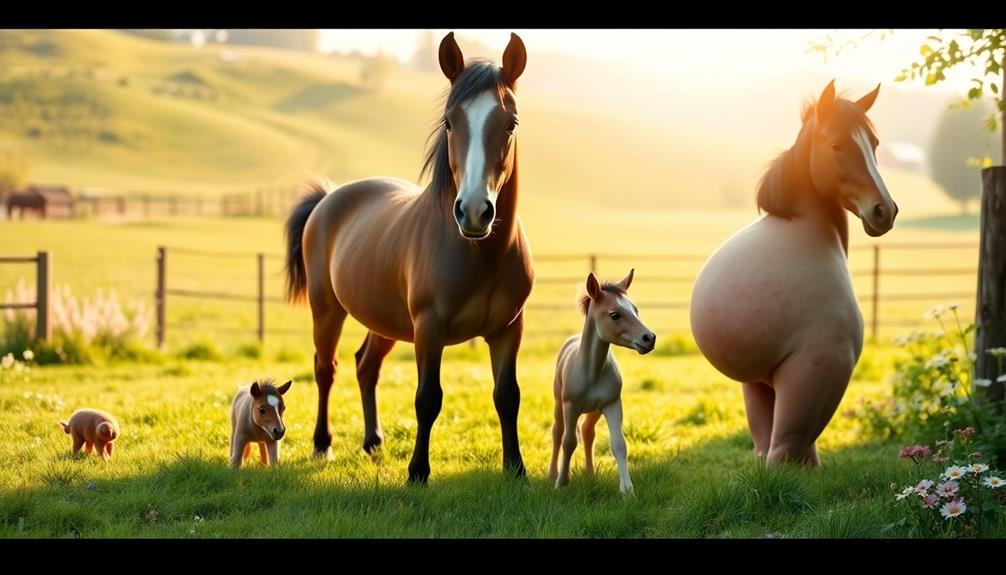
Understanding the stages of pregnancy development in miniature horses is essential for guaranteeing the health of both the mare and the foal. The gestation period typically lasts between 290 to 350 days, with an average around 326 days. Knowing the stages of pregnancy can help you provide the right care at the right times.
- Early Pregnancy (0-3 months): Within two weeks of conception, you can confirm pregnancy through ultrasound, with heartbeat detection occurring around day 25. By three months, identifiable features of the foal are visible on ultrasound.
- Mid-Pregnancy (3-6 months): As the pregnancy progresses into month six, you'll need to adjust the mare's nutrition and guarantee she receives regular veterinary vaccinations to support the foal's healthy development.
- Late Pregnancy (6-9 months): Near the end of the gestation period, around nine months, create a comfortable and stress-free environment for the mare. This guarantees a smoother delivery process and helps prepare her for the arrival of the foal.
Being aware of these stages allows you to support the mare effectively throughout her pregnancy.
Preparing for Foaling
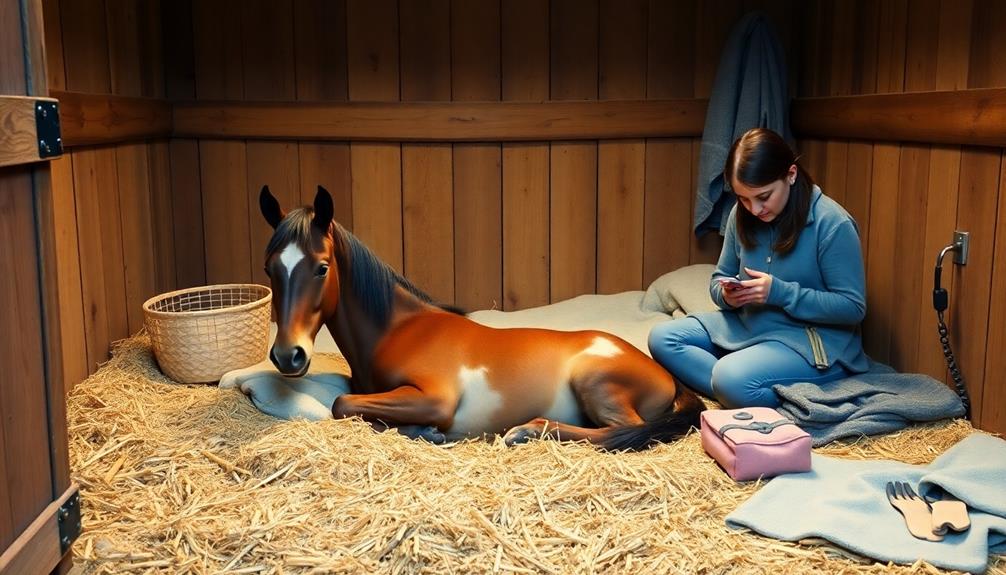
As you approach the end of your mare's pregnancy, start monitoring her for signs of impending foaling, like udder development and changes in behavior.
It's vital to keep a close eye on her health, ensuring she remains comfortable and stress-free in her maternity area.
Being prepared with essential supplies and a plan for monitoring will help you support her during this significant time.
Signs of Impending Foaling
Watching for signs of impending foaling is essential for ensuring the health and safety of your miniature mare and her foal. As she approaches her due date, typically around day 280 of her gestation, you'll notice specific indicators that labor is near.
Be vigilant for these signs of impending foaling:
- Udder Changes: You'll see udder swelling and filling starting about 4 to 6 weeks before delivery. The teats may also enlarge and develop waxy tips, a signal that foaling could occur within 24 hours.
- Behavioral Shifts: Your mare may become increasingly restless, frequently lying down and getting up. This restlessness is a natural response as her body prepares for labor.
- Physical Signs: Look for prominent veins on her udder and a noticeable sinking of her hips. These are signs that her muscles are relaxing, indicating that foaling is imminent.
Monitoring Mare's Health
Keeping a close eye on your mare's health during the final weeks of pregnancy is imperative for a successful foaling experience. Start monitoring her udder development around day 280 of gestation. Look for significant swelling and firmness, as these signs may indicate that foaling is imminent.
You should also pay attention to any behavioral changes. Increased restlessness and nesting behavior often signal that the mare is nearing labor.
Regular veterinary check-ups are essential for evaluating your mare's health and preparing for potential complications. It's important to observe her key signs, such as temperature and heart rate, to detect any abnormalities that might indicate stress or health issues.
Additionally, keep a watchful eye on udder size and the presence of wax on the teats. These clues can help you predict the timing of foaling, as it typically occurs within 24 hours of delivery.
Monitoring Mare's Health

Regularly monitoring a mare's health is essential, especially as she approaches the final stages of her pregnancy. As a horse owner, you should start this process around day 280, paying close attention to changes that may indicate impending foaling.
Here are three key areas to focus on:
- Udder Development: Look for signs of swelling or filling in the udder, which can indicate that the mare is nearing labor.
- Behavioral Changes: Notice any shifts in her behavior, such as increased restlessness or nesting behaviors, which may signal that foaling is imminent.
- Physical Condition: Keep track of appetite, weight gain, and abdominal enlargement; these are essential indicators of her overall health.
Regular veterinary check-ups are critical to guarantee the pregnancy is progressing normally and to catch any potential complications early.
Utilizing hormonal tests and ultrasound examinations can also provide valuable insights into her health status.
Equipment for Foaling Observation

When it comes to foaling observation, you'll want to invest in reliable monitoring systems to keep a close eye on your mare.
Essential equipment like a Breeder Alert system and an Arlo camera setup can make all the difference in ensuring timely responses during labor.
Let's go over the key tools you need for effective observation and how they can aid in a successful foaling process.
Monitoring Systems Overview
Effective monitoring systems are essential for breeders during the foaling process, ensuring that you can respond promptly to any signs of labor or complications.
With the right tools, you can keep an eye on your mares and feel confident in their care. Here are three key components to evaluate:
- Breeder Alert System: This innovative system detects when a mare lies down, sending you a beeper notification. It helps you monitor their behavior closely during critical moments.
- Arlo Camera System: For remote observation, this setup allows you to keep an eye on your mares from your smartphone or tablet. You can strategically place up to ten cameras throughout the barn and maternity area for extensive coverage.
- Portable Cameras: Use these outside during the day to monitor mares in their natural environment. This enhances your overall observation capabilities.
Essential Equipment Checklist
Having the right equipment on hand is vital for guaranteeing a smooth foaling process. First, invest in a Breeder Alert system to monitor your mare's lying down behavior. This device will alert you when she lies flat, signaling the onset of labor.
Also, set up an Arlo camera system for remote observation during the foaling period. Position ten cameras throughout the barn and maternity area to cover all angles of the mare's behavior and condition.
Consider using portable cameras that you can move outside during the day for flexible monitoring. This allows you to keep an eye on your mare no matter where she is.
It's essential to verify that all monitoring equipment is fully operational and tested before the expected foaling date. This way, you can be ready for timely intervention if needed.
Lastly, have essential items like clean towels and antiseptic solutions on hand to assist with the foal's delivery, especially for handling the umbilical cord.
With this essential equipment checklist, you'll be well-prepared for a successful foaling experience.
Post-Foaling Care and Management

Post-foaling care and management is essential for the health of both the mare and her new foal. Right after the mare goes through the birthing process, you'll need to take immediate steps to guarantee their well-being.
Here's a quick checklist for effective post-foaling care:
- Worm the Mare: Use paste Ivermectin to worm the mare promptly after foaling. This helps maintain her health and readiness for lactation.
- Treat the Foal's Umbilical Cord: Immediately treat the broken umbilical cord with iodine to prevent any risk of infection.
- Inspect and Dispose of the Placenta: Make sure to inspect the placenta and dispose of it within three hours to avoid complications.
In addition to these tasks, keep a close eye on the foal's nursing behavior and confirm it passes meconium in the first few hours. This verifies healthy digestive function.
Regular health checks for both the mare and foal are vital during the post-foaling period. By following these steps, you'll help support both the mare and her new foal as they adapt into this important stage of life.
Community Experiences and Insights

As you plunge into the world of miniature horse breeding, you'll quickly find that community experiences and insights can be invaluable. Many breeders report that the average gestation length for miniature horses hovers around 330 days, but it's vital to recognize the range of 290 to 350 days is common.
Some breeders have shared stories of early foaling, with viable foals born as early as 300 days, highlighting the unpredictability of when your mare might give birth.
Community insights stress the importance of closely monitoring physical signs of impending labor, like udder development and behavioral changes. These signs can vary considerably between individual mares, making it important for you to pay attention to your mare's unique indicators.
Additionally, environmental factors and the time of year can impact gestation length, with many breeders noticing shorter gestations in mares bred in specific seasons.
Breeders often exchange practical advice on preparing for foaling. Recognizing signs of distress in the mare and having contingency plans for unexpected early births can make all the difference.
Engaging with fellow breeders can help you navigate this exciting yet unpredictable journey.
Frequently Asked Questions
What Is the Gestation Period of a Mini Horse?
The gestation period for mini horses typically ranges from 290 to 350 days, with an average around 330 days. Each mare's individual health and history can influence how long she carries her foal.
How Early Can a Miniature Horse Foal?
A miniature horse can foal as early as 290 days into gestation, but that's rare and risky. Typically, you should expect foaling around 330 days, so keep a close eye on your mare.
What Are Foaling Signs in Miniature Horses?
You'll notice signs of impending foaling in miniature horses like udder development, wax on teats, increased restlessness, and visible veins. Keep a close eye on her behavior and physical changes as delivery approaches.
How Long Are Shetland Ponies Pregnant?
Shetland ponies typically carry their foals for 300 to 350 days, averaging around 330 days. Keep an eye on the mare's signs, as factors like age and health can influence her pregnancy duration.
Conclusion
To sum up, understanding mini horse gestation is key to ensuring a healthy pregnancy and foal. Did you know that mini horses typically carry their foals for about 10 months, just like standard horses? By monitoring your mare's health and recognizing the signs of pregnancy, you can create a supportive environment for her. With the right care and equipment, you'll be well-prepared for the exciting arrival of a new miniature companion. Happy foaling!
